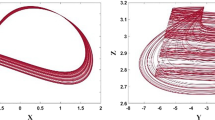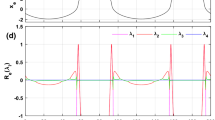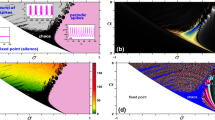Abstract
In this article we analytically solve the Hindmarsh–Rose model (Proc R Soc Lond B221:87–102, 1984) by means of a technique developed for strongly nonlinear problems—the step homotopy analysis method. This analytical algorithm, based on a modification of the standard homotopy analysis method, allows us to obtain a one-parameter family of explicit series solutions for the studied neuronal model. The Hindmarsh–Rose system represents a paradigmatic example of models developed to qualitatively reproduce the electrical activity of cell membranes. By using the homotopy solutions, we investigate the dynamical effect of two chosen biologically meaningful bifurcation parameters: the injected current I and the parameter r, representing the ratio of time scales between spiking (fast dynamics) and resting (slow dynamics). The auxiliary parameter involved in the analytical method provides us with an elegant way to ensure convergent series solutions of the neuronal model. Our analytical results are found to be in excellent agreement with the numerical simulations.



Similar content being viewed by others
References
Hindmarsh, J.L., Rose, R.M.: A model of neuronal bursting using three coupled 1st order differential equations. Proc. R. Soc. Lond. B221, 87–102 (1984)
Hodgkin, A.L., Huxley, A.F.: A quantitative description of membrane current and its application to conduction and excitation in nerve. J. Physiol. 117, 500–544 (1952)
Raninovich, M.I., Abarbanel, D.I., Huerta, R., Elson, R., Selverston, A.I.: Self-regularization of chaos in neural systems: experimental and theoretical results. IEEE Trans. CAS 44, 997–1005 (1997)
Wand, W., Wang, Y., Wang, Z.D.: Firing and signal transduction associated with an intrinsic oscillation in neuronal systems. Phys. Rev. E 57, R2527 (1998)
Baltanás, J.P., Casado, J.M.: Noise-induced resonances in the Hindmarsh–Rose neuronal model. Phys. Rev. E 65, 041915 (2002)
Huerta, R., Bazhenov, M., Rabinovich, M.I.: Clusters of synchronization and bistability in lattices of chaotic neurons. Europhys. Lett. 43, 719–724 (1998)
He, D.H., Zhan, M., Lu, H.P.: Periodic states with functional phase relation in weakly coupled chaotic Hindmarsh–Rose neurons. Phys. D 156, 314 (2001)
Liao, S.J.: The proposed homotopy analysis techniques for the solution of nonlinear problems. Ph.D. Dissertation. Shanghai Jiao Tong University, Shanghai (1992)
Liao, S.J.: Beyond Perturbation: Introduction to the Homotopy Analysis Method. CRC Press/Chapman and Hall, Boca Raton (2003)
Liao, S.J., Tan, Y.: A general approach to obtain series solutions of nonlinear differential equations. Stud. Appl. Math. 119, 297–355 (2007)
Lyapunov, A. M.: General Problem on Stability of Motion (English translation). Taylor & Francis, London (1992) (The original one was published in 1892 in Russian)
Adomian, A.: Nonlinear stochastic differential equations. J. Math. Anal. Appl. 55, 441–452 (1976)
Adomian, A.: A review of the decomposition method and some recent results for nonlinear equations. Comput. Math. Appl. 21, 101–127 (1991)
Adomian, A.: Solving Frontier Problems of Physics: The Decomposition Method. Kluwer Academic Publishers, Boston (1994)
Liao, S.J.: An explicit, totally analytic approximation of Blasius’ viscous flow problems. Int. J. Nonlinear Mech. 34, 759–778 (1999)
Liao, S.J.: On the homotopy analysis method for nonlinear problems. Appl. Math. Comput. 147, 499–513 (2004)
Abbasbandy, S.: Solution for the FitzHugh–Nagumo equation with the homotopy analysis method. Appl. Math. Model. 32, 2706–2714 (2008)
Bataineh, A.S., Noorani, M.S.M., Hashim, I.: Solving systems of ODEs by homotopy analysis method. Commun. Nonlinear Sci. Numer. Simul. 13, 2060–2070 (2008)
Mustafa, M., Khan, J.A., Hayat, T., Alsaedi, A.: Boundary layer flow of nanofluid over a nonlinearly stretching sheet with convective boundary condition. IEEE Trans. Nanotechnol. 14, 159–168 (2015)
Mustafa, M., Khan, J.A., Hayat, T., Alsaedi, A.: Analytical and numerical solutions for axisymmetric flow of nanofluid due to non-linearly stretching sheet. Int. J. Non-Linear Mech. (2015). doi:10.1016/j.ijnonlinmec.2015.01.005
Khan, H., Mohapatra, R.N., Vajravelu, K., Liao, S.J.: The explicit series solution of SIR and SIS epidemic models. Appl. Math. Comput. 215, 653–669 (2009)
Alomari, A.K., Noorani, M.S.M., Nazar, R., Li, C.P.: Homotopy analysis method for solving fractional Lorenz system. Commun. Nonlinear Sci. Numer. Simul. 15, 1864–1872 (2010)
Corson, N., Aziz-Alaoui, M.A.: Asymptotic dynamics of the slow-fast Hindmarsh–Rose neuronal system. Dyn. Cont. Disc. Imp. Syst. Ser. B. Appl. Algorithms 16, 535 (2008)
FitzHugh, R.: Impulses and physiological states in theoretical models of nerve membrane. Biophys. J. 1, 445–466 (1961)
Liao, S.: Advances in the Homotopy Analysis Method. World Scientific Publishing Co, Singapore (2014)
Acknowledgments
This work was partially funded by FCT/Portugal through the project PEst-OE/EEI/LA0009/2013. The authors would like to thank the anonymous reviewers of this article for all the helpful and constructive comments that have been made.
Author information
Authors and Affiliations
Corresponding author
Rights and permissions
About this article
Cite this article
Duarte, J., Januário, C. & Martins, N. On the analytical solutions of the Hindmarsh–Rose neuronal model. Nonlinear Dyn 82, 1221–1231 (2015). https://doi.org/10.1007/s11071-015-2228-5
Received:
Accepted:
Published:
Issue Date:
DOI: https://doi.org/10.1007/s11071-015-2228-5




